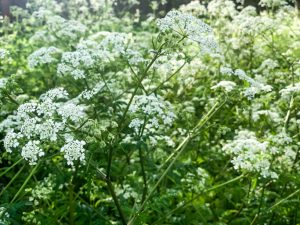Problem plants
Problem plants can be native or non-native species. They can cause environmental problems such as:
- suffocating other plant life
- being harmful to people or animals
- damaging buildings as they grow
Native species
There are 5 native plants that are considered a problem:
- Spear thistle
- Creeping or field thistle
- Curled dock
- Broad leaved dock
- Common ragwort
These plants contribute to biodiversity but landowners must meet requirements to avoid risks to livestock or crops.
If the plant is on private land we may ask the landowner to deal with it to stop it spreading.
There is information on how to identify these plants and stop them spreading on the gov.uk website.
Find out how we assess and where appropriate control ragwort on council-managed land in our ragwort policy.
If you cannot expand a section with a + sign, try refreshing your browser
More about ragwort
Common ragwort is a native plant that grows up to one metre tall with large, densely packed heads of bright yellow flowers.

It has a long flowering season making it an important nectar source for a high number of insect species, 29 of which depend entirely on ragwort for their existence. They include cinnabar moths, a bee species, hoverflies and a nationally scarce leaf beetle.
However it can be poisonous for livestock so must be kept away from land used for grazing or for fodder production.
Ragwort is subject to the Weeds Act of 1959 so landowners can be served with enforcement notices where necessary to make sure they stop it from spreading.
.
Non-native species
Some non-native plants cause problems because the pests and diseases that stop them spreading in their countries of origin are not present in the UK. This means they can become invasive and spread out of control.
It is illegal to plant invasive plants or cause them to spread in any way.
You should seek specialist advice for problem invasive plants on your own land and get rid of them quickly and safely. Invasive plants should not be composted or added to waste collections.
The gov.uk website has a list of invasive plants of concern and how to deal with them.
Types of invasive plants
If you cannot expand the sections below, try refreshing your browser.
Japanese knotweed
This is a plant that forms dense stands of tall, hollow, speckled canes during summer which die back in autumn.
During spring, reddish purple shoots appear and the plant grows rapidly. As leaves open up, the plant turns green.
It can grow up to three metres tall.
Knotweed can damage hard surfaces like tarmac or floors of houses as it grows.
It is best to deal with it while it is still small.
Knotweed on council land
If Japanese Knotweed is found on council land, we will treat it chemically between May and October each year.
We only treat Japanese knotweed between these months as this is when the weed is most receptive to treatment but we will take reports throughout the year.
The treatment process can take 3 to 4 years to be successful.
Knotweed on private land
There are 2 main ways of treating Japanese knotweed in your garden.
Chemical controls: The plant is resilient to cutting and sprouts from the roots. The most effective method of control is by herbicide application close to the flowering stage in late summer or autumn.
Non-chemical controls: Digging out is possible but due to the depth that the roots can penetrate, regrowth usually occurs. Try and remove as much of the root as possible then repeatedly destroy any regrowth. It will need drying out before burning.
Anyone burying Japanese knotweed waste should inform the Environment Agency at least 1 week before by calling 0370 850 6506.
Japanese knotweed cannot be disposed of in your rubbish or garden waste bin.

Giant hogweed
This plant can grow up to 7 metres tall. It looks like a larger version of common hogweed or cow parsley.
It has sturdy, dark reddish-purple stems and spotted leaf stalks that are hollow and produce thick bristles.
It flowers from May to July with white flowers clustered into an umbrella head that can be up to 80cm across. Giant hogweed can cause severe blisters on your skin. If you touch it wash the area immediately.

Himalayan balsam
This is a herb that can grow up to 2 metres tall. It has upright, purple-tinged stems and white, pink or purple flowers that appear from July to October. It spreads very quickly, particularly along riverbanks or in wetlands.

.
How to report problem plants
You can report problem plants in South Gloucestershire to us.
If the plant is on council land: use our report a problem with an open space form.
If it is on private land: call 01454 868000 or email streetcare@southglos.gov.uk
If we are responsible for the land where the plant is growing we will deal with it in accordance with our plant biosecurity policy.